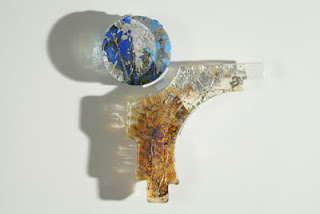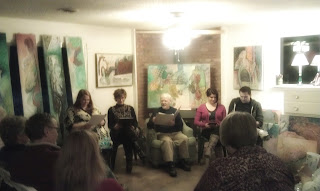“Cinderella”
an English Panto at Centerstage
reviewed
by Alec Clayton
 |
Erin Herrick as Cinderella,
Hilary
Heinz as Prince Charming and
Alexandra
Blouin as Dandini |
Children
as young as five or six and adults of all ages are equally enchanted by the
English panto or pantomime. I can’t think of any other form of staged entertainment
that has such broad appeal.
Like many
on this side of the pond I had never heard of the traditional British pantomime
until Alan Bryce, who cut his theatrical teeth in London’s famed West End,
brought this comedic art form to Centerstage Theatre in Federal Way. The first
one I ever saw was “Cinderella” with some of the same actors who grace the
stage in this production.
Pantos
have no relationship to silent pantomime from which the name is derived. More
like circus performances, children’s TV shows and Monty Python, these
pantomimes are modern versions of classical fairy tales filled with
cross-dressing actors, terrible puns, rocking popular music and lots of
audience participation.
They’re
anything but silent.
 |
Alexandra
Blouin and
Hilary
Heinz |
Certain
characters and traditions appear in every panto. There’s always a fairy
godmother who narrates the story, and one or more hideously ugly “women” (men
in outrageous drag), and beautiful women playing men, and there are always
local references and topical humor (the prince’s ball, for instance, is a disco
ball in Fife).
This
latest panto stars the charming Rosalie Hilburn as the Fairy Godmother; the
lovely Erin Herrick making her Centerstage debut in the title role; Erik
Gratton an Equity actor by way of New York and Los Angeles now living in
Seattle in the pivotal role of Buttons, Cinderella’s put-upon friend; Hilary
Heinz revisiting her role as Prince Charming; and Roger Curtis, also an Equity
actor, and Alan Bryce as the two ugly stepsisters. This is Curtis’s fifth time
playing an ugly dame in panto at Centerstage, and he owns the role. It’s
Bryce’s first time. He’s the artistic director at Centerstage and a seasoned
veteran both on stage and behind the curtain, so camping it up as a woman with
big lips is no stretch for him.
The kids
in the audience get a huge kick out of the antics on stage and love that
they’re called up to play a part and that the actors toss them candy, even if
they don’t get the adult jokes, which include pop-culture references and tend
to be mildly risqué. And it’s not just the kids who are included in the
audience participation. The ugly dames usually pick some innocent man in the
audience to flirt with. At Sunday’s matinee that lucky individual was a man in
the third row named Doug.
Theater at
its best is always magical; the whole transcends the parts. In the case of a
fairy tale such as this, the lighting, the music and the costumes combine to
create an ethereal atmosphere that transports audience members into a fantasy
world. The costumes by Ron Leamon are lavish and beautiful, especially
Cinderella’s ball gown and the dashing outfits worn by Prince Charming and his
servant, which in keeping with panto tradition show a lot of their long and
shapely legs — and the magic pumpkin coach created by Steffon Moody works magic
even on this jaded old critic.
Heinz, who
played Prince Charming in both the 2007 production of “Cinderella” and in
“Sleeping Beauty” at Centerstage, is tall and regal, and she is a commanding
presence. When she sings rocking numbers like the finale “Your Love Takes Me
Higher,” her rhythm and enthusiasm are infectious. Equally regal is Alexandra
Blouin as Prince Charming’s servant Dandini. Plus she has all the great
physical moves of a circus clown. The program says she just took a year off
from acting to study clowning and physical theater forms at Dell’Arte
International in California, and that training shows in this performance.
Herrick, a
recent University of Washington graduate making her Centerstage debut, is a
fabulous find in the role of Cinderella. She projects a purity and sweetness that
endears her to the audience.
The other
lead actor who not-so-subtly steals the show every time he’s on stage is
Gratton as Buttons, by far the most adorable character on stage. Like Blouin,
Gratton has all the moves of a circus clown. And he has an amazingly expressive
rubber face. He projects sincere love toward Cinderella and toward all the kids
in the audience, and he projects true humility.
Also
outstanding are Sam Barker as Cinderella’s father, Baron Hardup, and ensemble
actors Katherine Jett and Zack Wheeler. Jett dies hilariously in the opening
scene but comes back in various ensemble roles, and Wheeler stands out as an
expressive dancer.
The common
phrase is musical comedy, and this is definitely both, with David Duvall doing
his usual fine job as musical director and pianist, and the comedy provided by
writer Paul Hendy, director Vince Brady and the cast. I do recommend this show
– enjoy!
Performance
times vary through Dec. 23, 3200 SW Dash Point Road,
Federal Way, 253-661-1444, http://www.centerstagetheatre.com


 Like Vanguard,
Like Vanguard,  The
The  Bison Bison
Bison Bison At first glance I did not at all like the
At first glance I did not at all like the  Of the album covers reviewed, my favorite is
Of the album covers reviewed, my favorite is  With
Clayton's insightful impressions and these musicians often-hidden
messages in their lyrics and artwork, it goes to show that music, like
art, has a myriad of layers and complexity, and perhaps you can tell an
album by it's cover.
With
Clayton's insightful impressions and these musicians often-hidden
messages in their lyrics and artwork, it goes to show that music, like
art, has a myriad of layers and complexity, and perhaps you can tell an
album by it's cover.





















